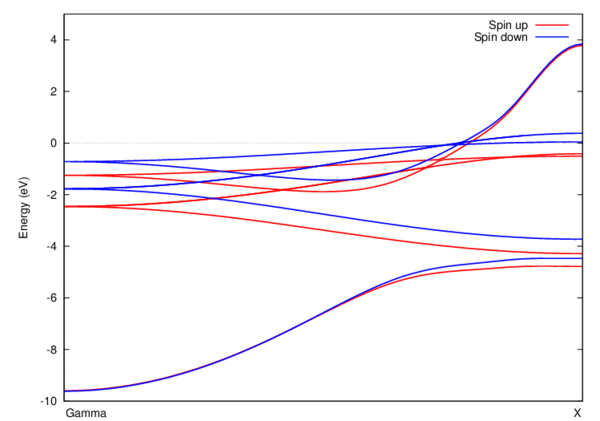Band structure of Ni: Difference between revisions
From phys824
Jump to navigationJump to search
Created page with "==Input files == * Save two files below as *.py files. ===band.py=== <pre> from gpaw import GPAW, FermiDirac from ase import Atoms from ase.io import read, write from gpaw..." |
No edit summary |
||
| Line 89: | Line 89: | ||
</pre> | </pre> | ||
== | ==Run job on ulam== | ||
==Plot the results== | |||
* If your jobs are successful, you should be able to reproduce this figure (using [http://www.gnuplot.info/ gnuplot] on Mills or transfer data to your Windows PC via sftp and use Origin): | |||
* | |||
<pre> | <pre> | ||
Revision as of 08:27, 8 November 2014
Input files
- Save two files below as *.py files.
band.py
from gpaw import GPAW, FermiDirac
from ase import Atoms
from ase.io import read, write
from gpaw import GPAW, PoissonSolver, MixerSum
from ase.structure import bulk
# -------------------------------------------------------------
# Bulk configuration
# -------------------------------------------------------------
a = 3.5249
atoms = bulk('Ni', 'fcc', a=a)
atoms.center()
write('system.traj', atoms)
for a in atoms:
if a.symbol == 'Ni':
a.magmom = 0.6
# Make self-consistent calculation and save results
calc = GPAW(h=0.18,
mode='lcao',
xc='PBE',
basis='dzp',
kpts=(8,8,8),
occupations=FermiDirac(width=0.05, maxiter=2000),
mixer=MixerSum(beta=0.010, nmaxold=8, weight=100.0),
poissonsolver=PoissonSolver(eps=1e-12),
txt='band_sc.txt')
atoms.set_calculator(calc)
atoms.get_potential_energy()
calc.write('band_sc.gpw')
# Calculate band structure along Gamma-X
from ase.dft.kpoints import ibz_points, get_bandpath
points = ibz_points['fcc']
G = points['Gamma']
X = points['X']
kpts, x, X = get_bandpath([G, X], atoms.cell, 80)
calc = GPAW('band_sc.gpw',
mode='lcao',
xc='PBE',
basis='dzp',
kpts=kpts,
txt='band_harris.txt',
fixdensity=True,
parallel={'domain': 1},
usesymm=None,
convergence={'bands': 'all'})
if calc.input_parameters['mode'] == 'lcao':
calc.scf.reset()
calc.get_potential_energy()
calc.write('band_harris.gpw')
find_band_as_dat.py
from ase.lattice import bulk
from gpaw import GPAW
calc = GPAW('band_harris', txt=None)
import numpy as np
eps_skn = np.array([[calc.get_eigenvalues(k,s)
for k in range(80)]
for s in range(2)]) - 10.75103
for n in range(10):
for k in range(80):
print k, eps_skn[0, k, n], eps_skn[1, k, n]
print
Run job on ulam
Plot the results
- If your jobs are successful, you should be able to reproduce this figure (using gnuplot on Mills or transfer data to your Windows PC via sftp and use Origin):
gnuplot> plot "result.dat" using 1:2 with lines title "Spin up", "result.dat" using 1:3 with lines title "Spin down"
 |